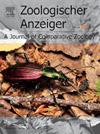基于三维摄影测量的群居田鼠(田鼠科)颅骨几何形态测量学分析
IF 1.5
3区 生物学
Q2 ZOOLOGY
引用次数: 0
摘要
几何形态计量学分析极大地推进了哺乳动物颅骨大小和形状变化的研究。在这项研究中,我们利用摄影测量学建立了鼠颅骨的三维模型,利用几何形态测量学方法研究了五个物种的形状变化。我们假设三维(3D)颅骨形状数据可以准确区分近亲物种。典型方差分析显示,基于二维和三维形状数据的物种分类水平相似。这些发现表明了摄影测量方法(三维几何形态测量)在形态相似和分类上有问题的类群(如鼠)中的精度和准确性。在具有相似二倍体染色体数目的种中(田鼠- m。hartingi和Microtus anatolicus-M。在线性形态测量分析(判别函数分析和方差分析)无法区分物种的群体中(dogramacii、schidlovskii和M. guentheri),基于摄影测量的3D GM分析显示了高水平的正确分类率,显示了聚类树突图中不同群体之间的差异,并显示了颅骨形状的显着差异。本文章由计算机程序翻译,如有差异,请以英文原文为准。
Three-dimensional (3D) photogrammetric-based geometric morphometric analysis of the skull in the social vole (Cricetidae: Microtus)
Geometric morphometric analysis has significantly advanced the study of size and shape variation of the mammalian skull. In this study, we used photogrammetry to build three-dimensional models of Microtus skulls to investigate the shape variation of five species using the geometric morphometric approach. We hypothesized that three-dimensional (3D) skull shape data would accurately discriminate between closely related species. Canonical analysis of variance revealed a similar level of species classification based on both 2D and 3D shape data. These findings indicate the precision and accuracy of the photogrammetric method (3D geometric morphometric) in morphologically similar and taxonomically problematic groups, such as Microtus. In species with similar diploid chromosome numbers (Microtus guentheri-M. hartingi and Microtus anatolicus-M. schidlovskii) and in groups in which linear morphometric analyses (Discriminant function analysis and MANOVA) could not distinguish between species (Microtus dogramacii, Microtus schidlovskii, and M. guentheri), the photogrammetry-based 3D GM analyses showed a high level of correct classification rates, demonstrated differences between groups in the cluster dendrogram, and showed significant differences in the shape of the skulls.
求助全文
通过发布文献求助,成功后即可免费获取论文全文。
去求助
来源期刊

Zoologischer Anzeiger
生物-动物学
CiteScore
2.80
自引率
7.10%
发文量
75
审稿时长
>12 weeks
期刊介绍:
Zoologischer Anzeiger - A Journal of Comparative Zoology is devoted to comparative zoology with a special emphasis on morphology, systematics, biogeography, and evolutionary biology targeting all metazoans, both modern and extinct. We also consider taxonomic submissions addressing a broader systematic and/or evolutionary context. The overall aim of the journal is to contribute to our understanding of the organismic world from an evolutionary perspective.
The journal Zoologischer Anzeiger invites suggestions for special issues. Interested parties may contact one of the editors.
 求助内容:
求助内容: 应助结果提醒方式:
应助结果提醒方式:


